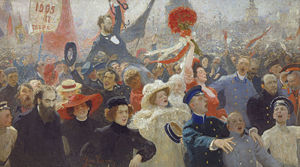- October Manifesto
-
The October Manifesto (Russian: Октябрьский манифест, Манифест 17 октября) was issued on 17 October, 1905 (30 October in the Gregorian calendar) by Tsar Nicholas II of Russia under the influence of Count Sergei Witte as a response to the Russian Revolution of 1905.
The official name of the document is The Manifesto on the Improvement of the State Order (Манифест об усовершенствовании государственного порядка). The manifesto addressed the unrest in Russia and pledged to grant civil liberties to the people: including personal immunity, freedom of religion, freedom of speech, freedom of assembly, and freedom of association; a broad participation in the Duma; introduction of universal male suffrage, uncensored newspapers and a decree that no law should come into force without the consent of the state Duma.
The manifesto was a precursor of the first ever Russian Constitution.
The manifesto and the constitution resulted in insignificant democratization as the Tsar continued to exercise veto power over the Duma, which he dissolved and reformed several times.
Opposition
The October Manifesto divided opposition to Tsar Nicholas II. It was issued on 30 October 1905, during the '1905 Revolution.' The Kadets were appeased by the idea of having freedom of speech and a truly representative government, and the Union of October 17 or more informally Octobrist Party took their name from this manifesto. However, the Marxists maintained that Nicholas had really only made a small concession. The Duma was only a shell of democracy as it could not pass laws without the approval of the Tsar and freedom of speech was heavily regulated. Nicholas II demonstrated his hold on power by dismissing the first and second Duma.
References
- The Memoirs Of Count Witte New York & Toronto (1921), Armonk, New York (1990). ISBN 0-87332-571-0.
- Fiehn, Terry. (1996). Russia & The USSR 1905-1941. Hodder Headline Group, London. ISBN 0-7195-5255-9.
Link
Categories:- Russian history stubs
- Russia politics stubs
- 1905 in Russia
- Politics of the Russian Empire
- Political manifestos
- 1905 works
- 1905 in politics
- Nicholas II of Russia
Wikimedia Foundation. 2010.

